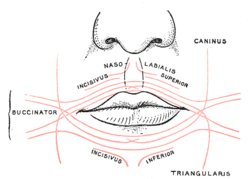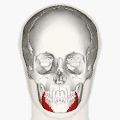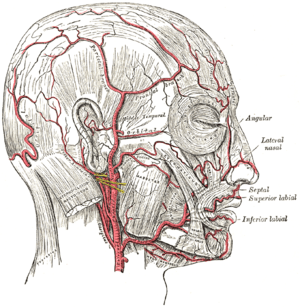Depressor anguli oris muscle
The depressor anguli oris (triangularis) is a facial muscle associated with frowning. It originates from the mandible and inserts into the angle of the mouth.
| Depressor anguli oris | |
|---|---|
 Scheme showing arrangement of fibers of Orbicularis oris (triangularis labeled at bottom right). | |
 Muscles of the head, face, and neck (labeled as triangularis near chin). | |
| Details | |
| Origin | Tubercle of mandible |
| Insertion | Modiolus of mouth |
| Artery | Facial artery |
| Nerve | Mandibular branch of facial nerve |
| Actions | Depresses angle of mouth |
| Identifiers | |
| Latin | Musculus depressor anguli oris |
| TA | A04.1.03.026 |
| FMA | 46828 |
| Anatomical terms of muscle | |
The muscle is innervated by the marginal mandibular branch of the facial nerve and receives its blood supply from the facial artery.
Anatomy
The depressor anguli oris arises from the oblique line of the mandible, whence its fibres converge, to be inserted, by a narrow fasciculus, into the angle of the mouth. At its origin it is continuous with the platysma, and at its insertion with the orbicularis oris and risorius; some of its fibers are directly continuous with those of the caninus, and others are occasionally found crossing from the muscle of one side to that of the other; these latter fibers constitute the transversus menti.
Function
The depressor anguli oris is a muscle of facial expression. The muscle depresses the corner of the mouth which is associated with frowning.
Additional images
 Position of depressor anguli oris muscle
Position of depressor anguli oris muscle Mandible, outer surface, side view
Mandible, outer surface, side view The arteries of the face and scalp
The arteries of the face and scalp
References
This article incorporates text in the public domain from page 383 of the 20th edition of Gray's Anatomy (1918)